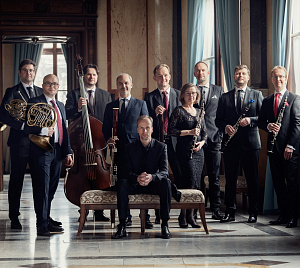
DES KNABEN WUNDERHORN BY PHILHARMONIA OCTET PRAGUE AND BARITONE PETER SCHÖNE
GENERIC INTERVIEW


Last week Supraphon released an intimate Mahler album made by PhilHarmonia Octet Prague, one of the most distinct representatives of the Czech wind tradition, and the outstanding German baritone Peter Schöne, which can be deemed the culmination of the ensemble’s seeking a revelatory repertoire. The chamber arrangements on the new album show an interesting path between the piano and orchestral versions, and allow for highlighting the colourfulness and intimacy of Mahler’s songs. Prior to the album’s release, we talked to two PhilHarmonia Octet Prague members – the bassoonist Václav Vonášek and the oboist Monika Fürbach Boušková.
How did PhilHarmonia Octet Prague arrive at the idea of making a recording of songs from Mahler’s Des Knaben Wunderhorn?
Václav Vonášek: The new album is a natural result of our development. A decade since the formation of our ensemble, we have realised that the Classical and Romantic wind octet repertoire simply doesn’t suffice – with regard to diversity and our artistic ambitions. Consequently, we decided to seek arrangements, ideally created upon our own request. The first composition we chose to have arranged for our needs was Mussorgsky’s Pictures at an Exhibition, which, thanks to Tomáš Ille, turned out really well and gave rise to the bold idea of sinking our teeth into Mahler too.
Why did you decide to invite the baritone Peter Schöne to work with you?
Monika Fürbach Boušková: From the very beginning, we had quite a clear idea of the singer. We wanted to address an artist of our generation, ideally from Germany, bearing in mind the declamation of the texts. But it wasn’t as easy as it may seem, as not all singers, neither in the Czech Republic nor abroad, have songs in their repertoire. Peter Schöne was recommended to us by Tomáš Brauner, music director of the Prague Symphony Orchestra. And it was an excellent choice – it turned out we were a perfect match – we and Peter understand each other both in artistic and personal terms, which we really appreciate! So, thanks Tomáš for your recommendation!
You selected ten of the cycle’s 24 songs. How difficult was it?
Václav Vonášek: Smaller forms are more suitable for a wind ensemble – one of the reasons being that is it possible to retain freshness, as well as some aloofness, when performing short pieces. Wind instruments splendidly underpin the character of songs with humorous and military themes. Yet it is more challenging to render Mahler’s breath-taking emotional passages. Owing in part to the added double bass, which markedly softens the ensemble’s sound, we could also undertake such gems as Wo die schönen Trompeten blasen and Urlicht. Our short list comprised 13 songs, originally instrumented by Mahler himself. Later on we whittled down the number, so as to lighten the burden on the soloist, as well as with the aim to get our ensemble to shine in the instrumental pieces, the movements Blumine and Scherzo from Mahler’s Symphony No. 1.
Did the recording go smoothly?
Monika Fürbach Boušková: The most difficult thing was to get together the dozens of musicians involved, who live either in the Czech Republic or Germany. Just like in the case of many other projects, the planning and the recording itself were repeatedly hampered by the Covid pandemic and the measures relating to it. I can say that we felt really happy when we finally sat down on the Rudolfinum stage with microphones and when the red signal first lit up. (Note: the recording director’s signal indicating that the recording is on.)